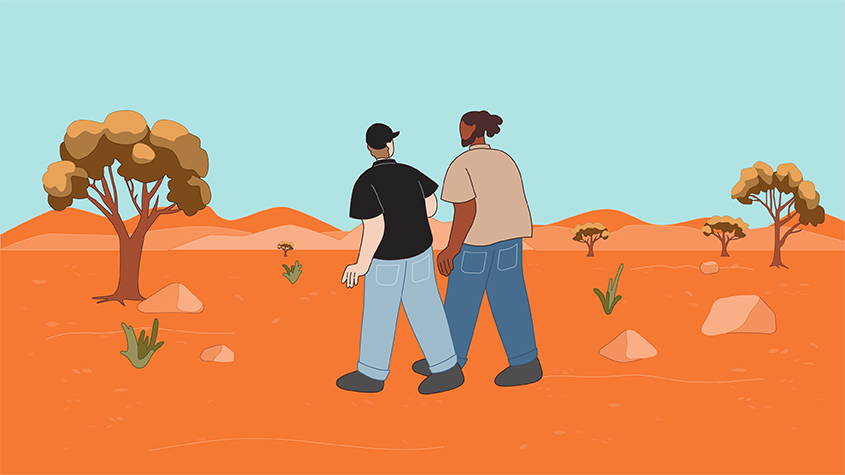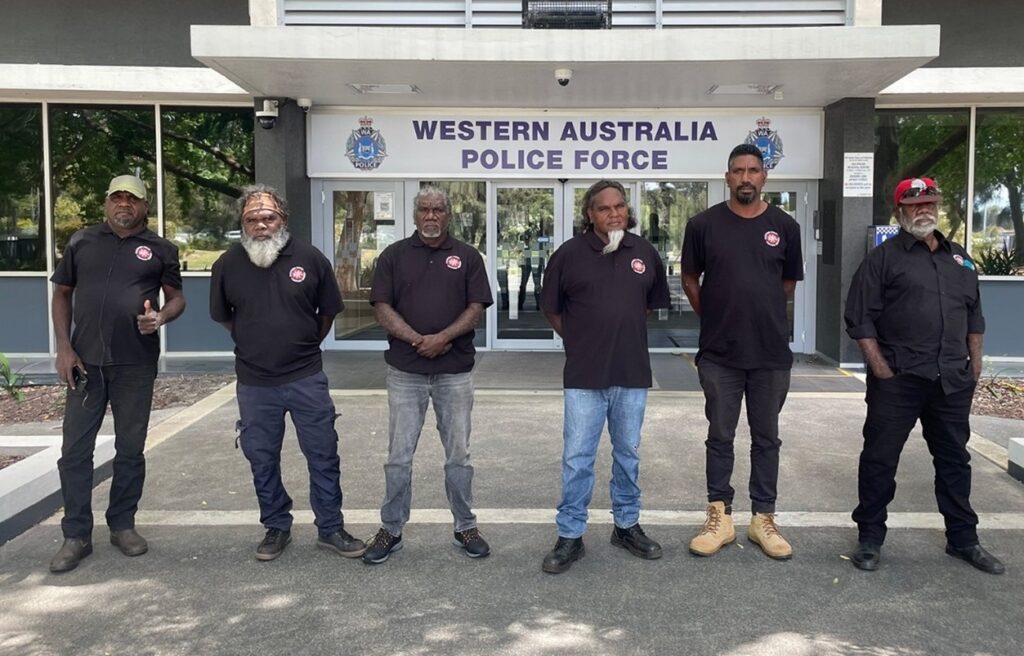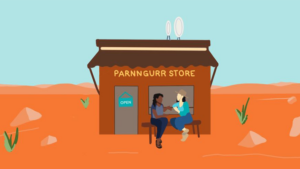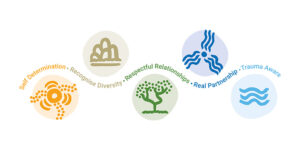
Walking the talk on Closing the Gap
Martu organisation, Kanyirninpa Jukurrpa (KJ) shows that there are ways to Close the Gap: one where Indigenous culture leads, community development guides, and partnerships sustain the work. This delivers results that are both culturally grounded and practically effective.

- Government is failing to Close the Gap. Despite commitments, governments have made little progress on Closing the Gap, with only a handful of targets on track and none of the priority reforms meaningfully implemented.
- The KJ Model shows a better way. Built over two decades by Martu people in partnership with non-Martu, it demonstrates how culture, community development, and genuine partnerships can create lasting change.
- KJ’s Yiwarra Kuju justice reform program proves the impact of Aboriginal-led solutions. This culturally grounded initiative shows how Martu-led approaches reduce incarceration and strengthen communities in ways mainstream systems cannot.
- Lessons for policymakers are clear: real reform requires sharing power, investing long-term, trusting culture as a foundation, and building relationships rather than focusing on compliance – principles that could transform government practice nationwide.
In the last two years, the Productivity Commission and the Coalition of Peaks both confirmed what Aboriginal and Torres Strait Islander peoples have long argued: government has not lived up to its own commitments on Closing the Gap. Both reviews of government’s progress towards Closing the Gap concluded that despite promises of reform, business as usual remains entrenched. Of the 19 national targets, only five are on track, and none of the four priority reforms have been meaningfully implemented.
The gulf between policy rhetoric and practical action has never been more stark, and the lack of meaningful progress suggests that governments are at a loss about what to do.
Against this backdrop, Walking the talk: What government can learn from the KJ Model, produced by SVA for Kanyirninpa Jukurrpa, or KJ, shines a light on a proven alternative.
It provides a real-world paradigm shift that could help Australia move beyond business as usual.”
The KJ Model – developed over two decades by Martu people in the Western Desert working with non-Martu partners – is a living demonstration of how government could work differently.
As KJ’s Executive Director, Zan King said, “KJ is grounded in Martu culture, community development, and equal partnerships. It provides a real-world paradigm shift that could help Australia move beyond business as usual.”
This article explores what the KJ Model contributes to the broader conversation about Closing the Gap, highlighting the lessons it offers for policy and practice.
The failure of business as usual
The National Agreement on Closing the Gap set out four priority reforms: formal partnerships and shared decision-making; building the community-controlled sector; transforming government organisations; and shared access to data.
It is too easy to find examples of government decisions that contradict commitments in the Agreement… that exacerbate, rather than remedy, disadvantage and discrimination.”
Yet the evidence is clear – governments have failed to meaningfully implement these reforms. Engagement remains transactional, siloed programs dominate, and communities are still positioned as passive recipients rather than genuine partners.
As the Productivity Commission noted: “It is too easy to find examples of government decisions that contradict commitments in the Agreement, that do not reflect Aboriginal and Torres Strait Islander people’s priorities and perspectives and that exacerbate, rather than remedy, disadvantage and discrimination.”
These failures are most acute in remote communities, where policy interventions often ignore local realities and perpetuate disengagement. What is needed is not incremental improvement, but a structural reimagining of how governments work with First Nations communities.
The KJ Model: A different way
KJ was established in 2005 and incorporated as a not-for-profit in 2009 to support Martu people to care for culture and country. Over time, it has grown into a holistic organisation spanning cultural, environmental, social, and family programs. Its approach, now known as the KJ Model, rests on three interdependent principles:
- Cultural foundations and methods – Martu culture sits at the centre of all decision-making and practice. Known as the old people’s organisation, KJ is grounded in Martu law, values and ways of working – the Martu perspective shapes every decision and program. “Martu are strong. Martu have the knowledge. With KJ, Martu are looking after their country and culture the right way. When the old people are finished, the young people must keep going,” said Muuki Taylor, OAM, Martu Elder.
- Community development ethos – Martu set priorities and shape initiatives on their own terms. To KJ, it means that the organisation’s overall mission is to assist Martu to create the kind of society that they want, that they will find fulfilling. This means a departure from a conventional planning model in which concrete, government-set objectives are a prerequisite. As Elder Thelma Judson said: “It’s good because it belongs to all of us Martu, it belongs to all of the people. It is our organisation. It does what we want and need to do.”
- Partnerships and relationships – Martu and non-Martu work together as equals, bringing complementary skills and perspectives. This recognises that both Martu and non-Martu bring knowledge and understanding of their society to the partnership and that this can be a strength when, in so many aspects of their lives, Martu are required to negotiate their relationship to the Western world. “Before it was like blind was leading the blind and deaf was leading the deaf,” said a Martu person. “For me I’m still hungry, I want to learn more and more. I want to feed my own people. A little taste is not enough for me. The more we learn the more we can take it to others. It’s not just about us it’s about the community too.”
These principles are deeply interconnected and work together to create a whole that is more than the sum of its parts.
This gives us a chance to change our lives. We are now in charge.”
KJ is seen as making a meaningful difference on the issues that matter to Martu.
Martu are highly engaged with the organisation and view it as a vital vehicle for shaping their future in contemporary Australia. As one Martu participant described the impact: “I’m proud, happy – we can change the future for the better. Without this, we’d be drinking, in lock-up, fighting – KJ have changed a lot of people’s lives. This gives us a chance to change our lives. We are now in charge.”
From a government perspective, the KJ Model challenges old assumptions. As one officer from the WA Department of Justice reflected: “It’s a different and transformative way of working… encouraging government to think differently and trust that Aboriginal people understand their issues better than anyone else, what’s needed and how to support them to create a better future.”
Why the KJ Model works
The effectiveness of the KJ Model lies in how these principles reinforce each other.
Cultural grounding ensures programs resonate with Martu priorities. A community development ethos means initiatives evolve with Martu aspirations. Genuine partnerships allow for sustained collaboration and intercultural innovation.
“It listens to Martu and grows with us. We try new programs and keep growing. ”
This contrasts sharply with government’s business as usual, which typically involves externally designed, siloed programs with narrow objectives. KJ instead delivers integrated, place-based strategies that respond to the interconnected realities of Martu life.
Importantly, KJ’s evaluation approach is also different. Rather than focusing on funder requirements, KJ prioritises Martu voices, embedding reflection and adaptation into its practice. As one Martu person said: “It listens to Martu and grows with us. We try new programs and keep growing. KJ listens to Martu. It comes from Martu.”
As a result, Martu engagement is consistently high, and programs are seen as vehicles for shaping their future.
Case study: Yiwarra Kuju – a culturally led justice reform pilot
One of the most powerful demonstrations of the KJ Model in action is Yiwarra Kuju, the Martu Diversionary Program. Funded initially by the WA Department of Justice, the program tackles high incarceration rates among Martu people by embedding justice reform within Martu culture, community and leadership.

At its heart, Yiwarra Kuju seeks to keep Martu out of prison, or support them not to return. Unlike mainstream diversionary programs, it is not imposed from outside; it is led by Martu, shaped by their cultural authority and community priorities.
Yiwarra Kuju has four key components:
Prison Program – Martu facilitators run workshops inside prisons, blending cultural education with practical support for navigating the justice system. One Martu facilitator described the effect: “We can provide them with hope. After a couple of workshops, they already start to get hope. We give them confidence Martu to Martu. They are more confident. They get excited.”
Wangka Minyirnpa – Panels of Martu Elders work with offenders to create realistic plans for avoiding reoffending, making recommendations to courts and the Prisoner Review Board. This places Martu decision-making at the centre of justice processes. According to one person, “Wangka Minyirrpa is serious, everyone says you have to talk serious, well that’s what we do, supporting, helping one another, all connected.”
Transport – Recognising the risks of reoffending in Newman, KJ provides transport for people leaving prison back to remote communities, helping them reconnect with family, culture, and country. A Martu person said: “If KJ doesn’t send a car then it’s hard for them to get a lift and they’ll end up in town. They’ll feel lost, frustrated and alone, no support.”
Transition – Ongoing support for employment, training, and cultural engagement helps build confidence and aspiration, creating pathways to stability and leadership.
For government, Yiwarra Kuju represents a significant shift. A WA Department of Justice officer noted: “Aboriginal people are at the front and centre leading the conversation and meetings, as well as the organisation of it, delivery of it, and the follow up after as well. There’s a throughcare process and they are heavily involved in the decision-making around it.”
It shows how systemic issues can be addressed through Aboriginal-led solutions that strengthen connection to culture and community.”
The program exemplifies what happens when government enables Aboriginal-led innovation. As Dr Ann Ingamells, Senior Researcher at Griffith University who evaluated Yiwarra Kuju, observed: “Martu are delivering services in relation to the criminal justice system. Yet, they are not simply working for government to deliver government designed services. Yiwarra Kuju is their aim. Each program is a thoughtful response to what Martu can see is needed if their vision is to be a reality.”
“Yiwarra Kuju is more than a program,” said King. “It is a culturally legitimate justice reform model with national significance. It shows how systemic issues can be addressed through Aboriginal-led solutions that strengthen connection to culture and community.”
Lessons for government and policy makers
The KJ Model does not offer a simple blueprint. It cannot be transplanted wholesale into other contexts. But it does provide guiding principles that are highly relevant for governments seeking to realise the aspirations of the National Agreement. For policy makers, several lessons stand out:
- Power sharing is non-negotiable. Without genuine joint decision-making, efforts at reform will fail. The KJ Model demonstrates how intercultural governance structures can work in practice.
- Invest in long-term, integrated strategies. Short-term, siloed funding undermines community development. Governments must support holistic, place-based approaches that reflect interconnected priorities. As one Martu man succinctly put it: “Martu don’t have programs, they just have Martu.”
- Evaluate differently. Evaluation must be accountable first to communities. Policy makers should prioritise community-defined success measures alongside traditional metrics.
- Trust in culture as a foundation. Aboriginal cultures are not barriers to modern development – they are powerful assets. Programs grounded in culture have the greatest chance of lasting impact.
- Adapt, don’t impose. The KJ Model was shaped by Martu priorities and will look different elsewhere. Policy makers must enter partnerships with humility, prepared to learn and adapt.
- Prioritise relationships, not compliance. Sustainable reform grows from trust-based partnerships, not contractual obligations. Time spent building genuine relationships is essential.
- Transformation is holistic. The strength of the KJ Model lies in how its principles reinforce each other. Picking one element – like cultural safety or co-design – without the others risks falling back into fragmented, ineffective practice.
“The strength and wisdom of Aboriginal communities have never been the barrier. What’s lacking is the imagination and bravery of governments to truly listen, to stand beside that knowledge, and to change the systems that keep failing,” said King. “Real progress starts by working from the foundation of Martu knowledge and priorities.”
Conclusion
Walking the talk offers governments an invitation, not a prescription. The KJ Model shows that another way is possible: one where Aboriginal culture leads, community development guides, and partnerships sustain the work. Yiwarra Kuju, as a Martu-led justice reform initiative, exemplifies how this approach delivers results that are both culturally grounded and practically effective.
For Closing the Gap to succeed, governments must move beyond rhetoric and embrace the paradigm shift. They must be willing to walk in the intercultural space, share power, and trust that Aboriginal communities know best how to shape their futures.
The choice is stark: persist with business as usual, and repeat the failures of the past; or learn from models like KJ, and begin to truly walk the talk.
For more information, read the full report: Walking the talk: What government can learn from the KJ Model.
The findings of this report drew on consultations with Martu community members over a number of years, including a series of consultations with KJ’s Board members and community members in four remote communities across the Western Desert conducted by KJ in 2024 and 2025. It also drew on several independent reports on KJ programs by non-Martu researchers and experts. We would like to acknowledge the generosity and contributions of all of these people.
Meet the team
We work with First Nations organisations and communities.
-
 Director, Consulting (VIC) Simon Faivel
Director, Consulting (VIC) Simon Faivel -
 Principal, Consulting (VIC) Jonathan Finighan
Principal, Consulting (VIC) Jonathan Finighan -
 Analyst, Consulting (VIC) Harvey Jaques Mitchell
Analyst, Consulting (VIC) Harvey Jaques Mitchell








